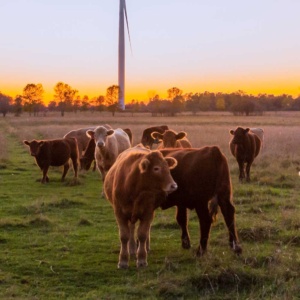What this critical trace mineral means to your cattle
By Gilda V. Bryant
Photos by Jodi Weber
Many guys and gals make sure their cow-calf herds receive timely vaccinations, quality forage and hay, topped off with a mineral supplement program that includes trace minerals.
One crucial trace mineral is zinc because it is involved in over 300 enzymes and enzyme systems in beef cattle, allowing animals to function at peak efficiency. It is vital for skin integrity and repair as well as boosting immune systems and carbohydrate metabolism. Important for successful reproduction, zinc enables bulls to produce healthy, mobile sperm.
This element is the second highest concentrated trace mineral in beef cattle after iron, which is the highest. Zinc is essential for insulin production and hoof health, as well as normal growth and development for calves. It also has a major role in vitamin A transport and protein synthesis.
Shawn Archibeque, Ph.D., P.A.S., Rumen Nutritionist at Colorado State University, reports that zinc primarily functions as a component of enzymes. Cells manufacture enzymes, which are proteins that initiate various biological functions.
“The idea is that if the animal gets enough zinc to meet its requirements, those enzymes can function properly,” Archibeque explains. “The animal will grow and function in a normal manner. If it is deficient in zinc, then some of those enzymes won’t be able to work properly.”
Zinc deficiency symptoms range from increased salivation, swollen feet with open, scaly lesions, or severe skin sores that are usually found on the legs, neck, head and around the nostrils. Hair loss, decreased weight gain, and poor immune response are other signs of low zinc. In females, conception rates decrease and bulls have poor testicular growth, and low-quality sperm. White Muscle Disease, which is often fatal, may appear in calves.
Archibeque says that some studies suggest that animals respond more favorably to chelated zinc, however there are a large number of trials that have shown no difference in performance for animals fed zinc oxide instead of chelated zinc.
“My personal take is if you’re dealing with animals that are likely fed at [zinc] requirements, you’re probably not going to see any difference,” explains Archibeque. “If you’re dealing with animals that producers just barely met the minimum amount of zinc, [those cattle] may benefit from a chelated mineral.”
He also recommends loose minerals, cooked tubs and pressed blocks saying, “They all have their uses. I tend to recommend what works best with a producer’s given situation. If they have a high quality pasture, a loose mineral might work just fine. If they’re trying to move the supplementation around, blocks are a better choice. If the producer is dealing with low quality forages where they need to supplement protein, tubs work really well.”
Since most forages are low in zinc, Archibeque advises producers to supplement their cattle with a complete trace mineral package that meets the animals’ requirements.
“I don’t like the idea of supplementing individual minerals above and beyond those requirements because you can start to have reactions, where zinc can impair copper absorption,” Archibeque reports.
Balance is a challenge
Jason Russell, Ph.D., Research Nutritionist with Zinpro, says another challenge to cattle diets is keeping zinc and copper in balance, since they share the same storage mechanism in the cells. However, that storage protein has a slight preference for copper instead of zinc.
“If we overfeed zinc, we can end up with a secondary copper deficiency,” Russell explains. “That’s because the cells in the small intestine temporarily store trace minerals. That’s the next point of regulation after absorption that helps maintain optimum concentrations [of trace minerals]. When dietary zinc is high, small intestinal cells also harbor more copper because of the storage protein. Over time, those cells slough off and are excreted. So there goes that copper that was absorbed into the small intestine cells, but was never used further in the [animals’] metabolism.”
Protein and energy status also play a part in mineral absorption. Cell division and cellular repair require energy and protein, the stuff cells are made of. Minerals, such as zinc and copper, work hand in hand with protein and energy to ensure those enzyme systems work correctly.
Russell recommends providing a zinc amino acid complex. The benefits of providing complexed zinc to beef cattle include enhanced foot health and hoof health. The zinc complex prevents foot issues, helps improve skin condition, especially just above the hoof. Zinc is heavily involved in protein synthesis and energy metabolism. Russell says that zinc amino acid complex results in improved growth rate and feed efficiency.
“From a nutrition standpoint, work with a nutritionist whenever possible to balance out supplementation to your animals, or a total diet for your animals,” Russell recommends. “The other thing that is really important as we look at feed ingredients, whether they’re trace minerals, yeasts, or other ingredients, is making sure those
Zinc is a workhorse, maintaining some 300 enzyme and enzyme systems. The proper amounts of zinc ensure healthy, productive cattle in cow-calf and stocker operations, as well as the feedlot.
ZINC IN THE FEEDLOT
By Gilda V. Bryant
Zinc supplementation is vital for all production stages of the beef cattle industry. On the cow-calf side, calves utilize this mineral for normal growth and development as well as immune function. It also carries over to the feedlot, especially for immune status, hoof health and mobility, and efficient weight gain. John Richeson, Ph.D., Assistant Professor of Animal Science at West Texas A&M University, also specializes in feedlot research. He says that zinc will help a high-risk calf entering the feedlot.
High-risk calves are those animals that have received little or no mineral supplementation, and were weaned either right before going to the feedlot or during transport. They may not have had immunizations before they travel in a crowded trailer with strange animals. All of these factors cause stress, which in turn, lowers their immunity to diseases, especially BRD (bovine respiratory disease).
“Those high-risk cattle are more likely to arrive zinc deficient than a backgrounded animal,” Richeson reports. “An important consideration in the feedlot is the type of cattle you’re purchasing.”
What form of zinc does Richeson like to see feedlots provide to calves?
“You’ve got to consider the type of cattle,” he says. “Their expected mineral status upon arrival would influence my decision. Just consider the cost difference between an inorganic versus organic bioavailability and go from there.”
The organic forms are more readily available to the animal because they are protected from the microflora in the rumen. Bypassing the rumen allows them to be absorbed in the small intestine.
“Listen to your nutritionist,” advises Richeson. “I think current zinc requirements that are provided by the National Research Council (NRC), which is the gold standard for nutritional supplementation, are probably too low. You’ll see that most consulting nutritionists will suggest a zinc and copper concentration much greater than what’s indicated in the NRC. There’s a recent report in which consulting nutritionists were interviewed around the country about their nutritional recommendations. The protein and trace mineral recommendations varied quite a bit. The common thing was they all recommended higher amounts of zinc and copper than what the NRC states.”
Does additional zinc enhance carcass quality in the feedyard? Shawn Archibeque, Ph.D., P.A.S., Rumen Nutritionist at Colorado State University, says that if calves were deficient and then supplemented with zinc, there probably would be some improvement in carcass quality. “If calves are adequate and you supplement above that, you typically don’t see big changes in carcass quality. I haven’t seen enough consistent data that convinces me there’s any impact on carcass characteristics at this point.”
Zinc Deficiency Symptoms
-Increased salivation
-Swollen feet with open, scaly lesions
-Severe skin sores on the legs, neck, head and around the nostrils
-Hair loss
-Decreased weight gain
-Poor immune response
-Conception rate decrease
-Poor testicular growth
-Low-quality sperm
-White Muscle Disease in calves






